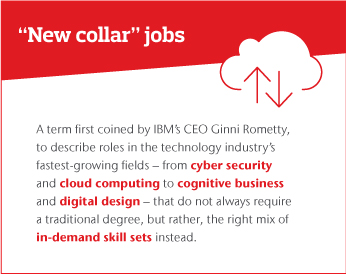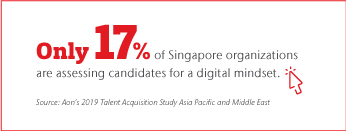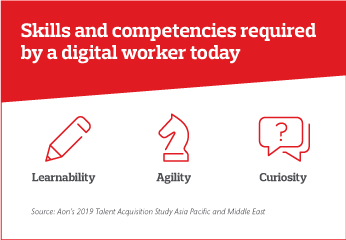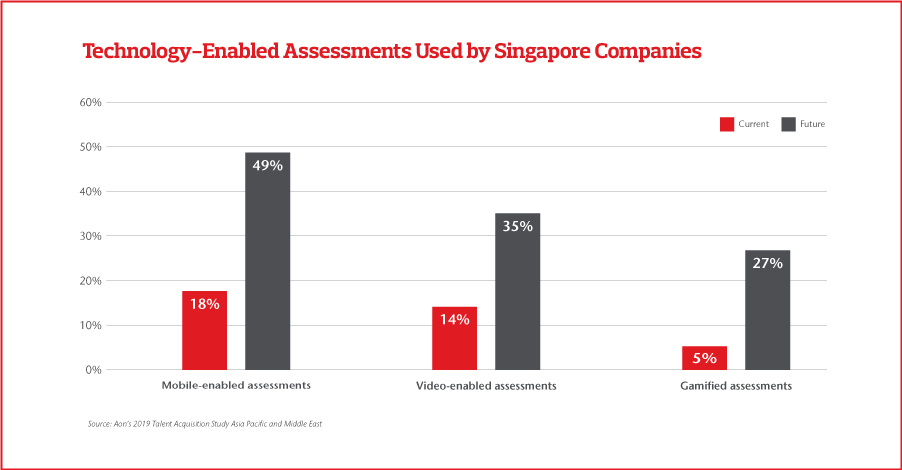
Hiring For The Future: How Can Asia Win The Talent War?
OVERVIEW
The workplace is undergoing a rapid transformation, driven by the same digital disruption that is transforming many other facets of the way we live. Whole job categories are being eliminated, even as acute shortages in other areas emerge.
Organizations around the world are scrambling to find and develop the talent they need to keep pace with these unrelenting pressures. Consequently, hiring managers have come under the spotlight to meet new demands. Their responsibility to fill the right job, with the right person, at the right time requires a shift to a new model from one that hired and fired as and when it was needed to one focused on a sustainable talent supply.
How can business leaders think about talent needs as a means to achieve business strategy?
IN DEPTH
“The success of businesses today depends on the degree of ‘digital readiness’ of the people they employ, more so than products, services or strategy. The talent’s ability to embrace the digital transformation at work and keeping up with the same is giving organizations the winning edge,” says Ishita Bandyopadhyay, Practice Lead, Aon Assessment Solutions, Southeast Asia Aon.
However, the tables have turned on employers across Asia struggling to attract and retain the right talent. In the 10 years following the global financial crisis, companies have had the upper hand in the hiring process thanks to a large supply of candidates.
But, in today’s job market, digital disruption, coupled with critical skills gaps among a limited talent pool, has resulted in hyper-competitive markets. Talent acquisition teams are now thrust into the spotlight to fill the right job, with the right person, at the right time. This means setting up a sustainable and adaptable source of talent.
Hiring for Proficiency over Pedigree
The world’s economy is undergoing a Fourth Industrial Revolution, where businesses, their processes, and their plants are connected online. Jobs are changing as a result of these digital transformations, and education is struggling to keep pace with this changing world of work. “Many companies that solely rely on the traditional four-year-degree hiring criteria are struggling to find talent with the right skills that support digital innovation,” says Tarandeep Singh, Partner and APAC & ME Assessment Practice Leader, Aon.
The scarcity of employable talent in Asia today is most apparent in Singapore, which is facing the highest hot skill deficit of the decade. Hot skills are generally related to new technology that few people in a given geography or industry have experience using. These include skills related to Artificial Intelligence, Machine Learning, and the ability to manage data and complexity (e.g. Data Sciences/Big Data/Data Visualization). More than half (59 percent) of Singapore employers say they can’t fill open jobs, higher than the global average of 45 percent, according to Aon’s 2019 Talent Acquisition Study Asia Pacific and Middle East.
This war for talent has prompted a global shift toward valuing skills over formal credentials and an interest in finding new ways to test and develop those skills efficiently. For example, IBM partnered with Coursera to create an education portal that offers digital badges (digital credentials that are easily shareable on professional networking sites such as LinkedIn) in areas such as data science, cloud services and IBM micro-services. These courses are open to the public, allowing the company to increase the pool of available talent with the hot skills they require, even though they may not have traditional qualifications. Besides having a ready-trained workforce they can deploy on projects, additional benefits of directing current and new employees to the platform include minimal training cost incurred post recruitment and a lesser churn as learners develop more ownership in their roles.
Currently, as many as a third of IBM employees have less than a four-year college degree. IBM is not the only employer redefining this space. Besides leading tech giants such as Apple, Google and Netflix, Bank of America, Hilton, and even the world’s largest general-interest paperback publisher, Penguin Random House, are among leading employers doing away with the need for graduate degrees.
Companies like IBM foresee that lasting job creation will require an understanding of important new dynamics in the global labor market – not about white versus blue collar jobs, but rather, about “new collar” jobs that employers in many industries demand, yet remain largely unfilled.
 The new reality of “new collar” jobs requires employers – and, more importantly, the talent acquisition function – to think differently about hiring and retaining talent. “As companies continue on the path of digital transformation, they must start hiring for a digital mindset to build a strategic talent supply for a future-ready workforce,” says Singh.
The new reality of “new collar” jobs requires employers – and, more importantly, the talent acquisition function – to think differently about hiring and retaining talent. “As companies continue on the path of digital transformation, they must start hiring for a digital mindset to build a strategic talent supply for a future-ready workforce,” says Singh.
In today’s job market, skills can quickly become obsolete. This means organizations need to focus on hiring people with the willingness and ability to continuously acquire new skills and knowledge. Most companies realize the lack of these skills within their workforce, with few of them actively addressing this shortage via talent development or talent acquisition strategies. Just 20 percent of organizations in Asia Pacific and Middle East are measuring behaviors needed for digital readiness. In Asia’s most tech-savvy country, Singapore, only 17 percent of organizations are assessing candidates for digital mindset.
 A combination of personality, cognitive and behavioral assessments can help companies hire for digital disruption. “In fact, firms that leverage tech-enabled assessment have more effective branding initiatives, tend to spend less time on interviews and have fewer interview rounds, streamlining the experience for the candidate and saving companies money,” Singh explains.
A combination of personality, cognitive and behavioral assessments can help companies hire for digital disruption. “In fact, firms that leverage tech-enabled assessment have more effective branding initiatives, tend to spend less time on interviews and have fewer interview rounds, streamlining the experience for the candidate and saving companies money,” Singh explains.
 However, only a small percentage of companies are using digital technologies to create appropriate experiences for its candidates. In Singapore, just a third are using technology-enabled assessments covering personality, cognitive ability, and behaviors to seek candidates with the right competencies. Also, with only 60 percent of companies having dedicated talent acquisition teams (the lowest ratio in Asia Pacific), companies in Singapore struggled to achieve their strategic talent priorities in 2018. “The country is playing catch-up with the region in deploying technology-enabled assessments, measuring return on employer branding, and capturing candidate feedback,” says Bandyopadhyay.
However, only a small percentage of companies are using digital technologies to create appropriate experiences for its candidates. In Singapore, just a third are using technology-enabled assessments covering personality, cognitive ability, and behaviors to seek candidates with the right competencies. Also, with only 60 percent of companies having dedicated talent acquisition teams (the lowest ratio in Asia Pacific), companies in Singapore struggled to achieve their strategic talent priorities in 2018. “The country is playing catch-up with the region in deploying technology-enabled assessments, measuring return on employer branding, and capturing candidate feedback,” says Bandyopadhyay.
The good news though, is that Singapore’s talent acquisition teams are beginning to see the need to rethink their candidate assessment strategies if they want to own the talent supply dimension for the business. Things are looking up for Singapore, with immersive assessment experiences set to rise significantly in the future.
“Both business and talent acquisition professionals say that ‘gut feel’ is no longer valid in hiring,” Bandyopadhyay explains.

Sharper, more holistic assessment of talent
While there is a greater interest in deploying scientific tools for talent selection and assessment in Singapore, Bandyopadhyay sees a gap in two areas – technology adoption, and the ability of talent acquisition professionals and hiring managers to interpret assessment-related data.
To build a workforce of the future, companies must target the candidates with the skills and competencies to achieve elite results, says Bandyopadhyay. “AI-enabled sourcing and candidate relationship management tools are key to doing this successfully,” she explains. “Talent acquisition professionals must deliver a candidate experience that is in sync with their customer-facing brand and have the skills to use social media to engage passive job-seekers effectively.”
According to research, candidates are 14 times more likely to click on and apply for jobs in programmatic, targeted ads than they are to job results found during one of their own keyword searches.
This new recruitment frontier calls for talent acquisition professionals to grow their own skills and practice novel ways of engaging with candidates – and leaders who champion this adaptive behavior.
“The ability to understand what matters to the business and make improvements that add value to your talent will get you noticed and enhance your own career as a talent acquisition professional,” says Singh.
On the business side, addressing your key talent challenges – and minimizing early attrition – improves your organization’s profitability and reputation, says Singh. Delivering these outcomes reinforces HR as a strategic business partner.
“When you recruit and engage the right employees, they’ll perform better – and that results in stronger business performance and higher customer satisfaction.”
